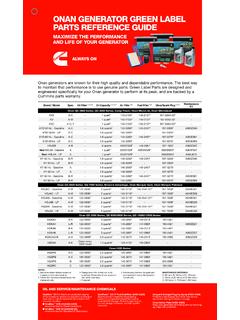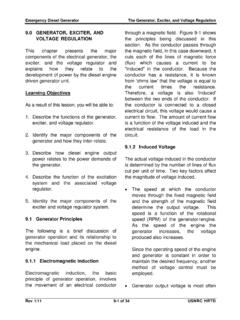Transcription of 3.3 Gasoline And Diesel Industrial Engines
1 Gasoline And Diesel Industrial GeneralThe engine category addressed by this section covers a wide variety of Industrial applicationsof both Gasoline and Diesel internal combustion (IC) Engines such as aerial lifts, fork lifts, mobilerefrigeration units, generators , pumps, Industrial sweepers/scrubbers, material handling equipment (suchas conveyors), and portable well-drilling equipment. The three primary fuels for reciprocating ICengines are Gasoline , Diesel fuel oil ( ), and natural gas. Gasoline is used primarily for mobile andportable Engines . Diesel fuel oil is the most versatile fuel and is used in IC Engines of all sizes. Therated power of these Engines covers a rather substantial range, up to 250 horsepower (hp) for gasolineengines and up to 600 hp for Diesel Engines . ( Diesel Engines greater than 600 hp are covered inSection , "Large Stationary Diesel And All Stationary Dual-fuel Engines ".)
2 Understandably,substantial differences in engine duty cycles exist. It was necessary, therefore, to make reasonableassumptions concerning usage in order to formulate some of the emission Process DescriptionAll reciprocating IC Engines operate by the same basic process. A combustible mixture is firstcompressed in a small volume between the head of a piston and its surrounding cylinder. The mixtureis then ignited, and the resulting high-pressure products of combustion push the piston through thecylinder. This movement is converted from linear to rotary motion by a crankshaft. The pistonreturns, pushing out exhaust gases, and the cycle is are 2 methods used for stationary reciprocating IC Engines : compression ignition (CI)and spark ignition (SI). This section deals with both types of reciprocating IC Engines . All Diesel -fueled Engines are compression ignited, and all Gasoline -fueled Engines are spark CI Engines , combustion air is first compression heated in the cylinder, and Diesel fuel oil isthen injected into the hot air.
3 Ignition is spontaneous because the air temperature is above theautoignition temperature of the fuel. SI Engines initiate combustion by the spark of an electricaldischarge. Usually the fuel is mixed with the air in a carburetor (for Gasoline ) or at the intake valve(for natural gas), but occasionally the fuel is injected into the compressed air in the Engines usually operate at a higher compression ratio (ratio of cylinder volume when thepiston is at the bottom of its stroke to the volume when it is at the top) than SI Engines because fuel isnot present during compression; hence there is no danger of premature autoignition. Since enginethermal efficiency rises with increasing pressure ratio (and pressure ratio varies directly withcompression ratio), CI Engines are more efficient than SI Engines . This increased efficiency is gainedat the expense of poorer response to load changes and a heavier structure to withstand the EmissionsMost of the pollutants from IC Engines are emitted through the exhaust.
4 However, some totalorganic compounds (TOC) escape from the crankcase as a result of blowby (gases that are vented fromthe oil pan after they have escaped from the cylinder past the piston rings) and from the fuel tank andcarburetor because of evaporation. Nearly all of the TOCs from Diesel CI Engines enter the10/96 Stationary Internal Combustion from the exhaust. Evaporative losses are insignificant in Diesel Engines due to the lowvolatility of Diesel primary pollutants from internal combustion Engines are oxides of nitrogen (NOx), totalorganic compounds (TOC), carbon monoxide (CO), and particulates, which include both visible(smoke) and nonvisible emissions. Nitrogen oxide formation is directly related to high pressures andtemperatures during the combustion process and to the nitrogen content, if any, of the fuel. The otherpollutants, HC, CO, and smoke, are primarily the result of incomplete combustion.
5 Ash and metallicadditives in the fuel also contribute to the particulate content of the exhaust. Sulfur oxides (SOx) alsoappear in the exhaust from IC Engines . The sulfur compounds, mainly sulfur dioxide (SO2), aredirectly related to the sulfur content of the Nitrogen Oxides -Nitrogen oxide formation occurs by two fundamentally different mechanisms. Thepredominant mechanism with internal combustion Engines is thermal NOxwhich arises from thethermal dissociation and subsequent reaction of nitrogen (N2) and oxygen (O2) molecules in thecombustion air. Most thermal NOxis formed in the high-temperature region of the flame fromdissociated molecular nitrogen in the combustion air. Some NOx, called prompt NOx, is formed in theearly part of the flame from reaction of nitrogen intermediary species, and HC radicals in the second mechanism, fuel NOx, stems from the evolution and reaction of fuel-bound nitrogencompounds with oxygen.
6 Gasoline , and most distillate oils have no chemically-bound fuel N2andessentially all NOxformed is thermal Total Organic Compounds -The pollutants commonly classified as hydrocarbons are composed of a wide variety of organiccompounds and are discharged into the atmosphere when some of the fuel remains unburned or is onlypartially burned during the combustion process. Most unburned hydrocarbon emissions result fromfuel droplets that were transported or injected into the quench layer during combustion. This is theregion immediately adjacent to the combustion chamber surfaces, where heat transfer outward throughthe cylinder walls causes the mixture temperatures to be too low to support burned hydrocarbons can occur because of poor air and fuel homogeneity due toincomplete mixing, before or during combustion; incorrect air/fuel ratios in the cylinder duringcombustion due to maladjustment of the engine fuel system; excessively large fuel droplets (dieselengines).
7 And low cylinder temperature due to excessive cooling (quenching) through the walls or earlycooling of the gases by expansion of the combustion volume caused by piston motion beforecombustion is Carbon Monoxide -Carbon monoxide is a colorless, odorless, relatively inert gas formed as an intermediatecombustion product that appears in the exhaust when the reaction of CO to CO2cannot proceed tocompletion. This situation occurs if there is a lack of available oxygen near the hydrocarbon (fuel)molecule during combustion, if the gas temperature is too low, or if the residence time in the cylinderis too short. The oxidation rate of CO is limited by reaction kinetics and, as a consequence, can beaccelerated only to a certain extent by improvements in air and fuel mixing during the FACTORS10 Smoke and Particulate Matter -White, blue, and black smoke may be emitted from IC Engines .
8 Liquid particulates appear aswhite smoke in the exhaust during an engine cold start, idling, or low load operation. These areformed in the quench layer adjacent to the cylinder walls, where the temperature is not high enough toignite the fuel. Blue smoke is emitted when lubricating oil leaks, often past worn piston rings, into thecombustion chamber and is partially burned. Proper maintenance is the most effective method ofpreventing blue smoke emissions from all types of IC Engines . The primary constituent of blacksmoke is agglomerated carbon particles (soot) formed in regions of the combustion mixtures that areoxygen Sulfur Oxides -Sulfur oxides emissions are a function of only the sulfur content in the fuel rather than anycombustion variables. In fact, during the combustion process, essentially all the sulfur in the fuel isoxidized to SO2. The oxidation of SO2gives sulfur trioxide (SO3), which reacts with water to givesulfuric acid (H2SO4), a contributor to acid precipitation.
9 Sulfuric acid reacts with basic substances togive sulfates, which are fine particulates that contribute to PM-10 and visibility reduction. Sulfuroxide emissions also contribute to corrosion of the engine Control TechnologiesControl measures to date are primarily directed at limiting NOxand CO emissions since theyare the primary pollutants from these Engines . From a NOxcontrol viewpoint, the most importantdistinction between different engine models and types of reciprocating Engines is whether they arerich-burn or lean-burn. Rich-burn Engines have an air-to-fuel ratio operating range that is nearstoichiometric or fuel-rich of stoichiometric and as a result the exhaust gas has little or no excessoxygen. A lean-burn engine has an air-to-fuel operating range that is fuel-lean of stoichiometric;therefore, the exhaust from these Engines is characterized by medium to high levels of O2.
10 The mostcommon NOxcontrol technique for Diesel and dual-fuel Engines focuses on modifying the combustionprocess. However, selective catalytic reduction (SCR) and nonselective catalytic reduction (NSCR)which are post-combustion techniques are becoming available. Controls for CO have been partlyadapted from mobile modifications include injection timing retard (ITR), preignition chambercombustion (PCC), air-to-fuel ratio adjustments, and derating. Injection of fuel into the cylinder of aCI engine initiates the combustion process. Retarding the timing of the Diesel fuel injection causes thecombustion process to occur later in the power stroke when the piston is in the downward motion andcombustion chamber volume is increasing. By increasing the volume, the combustion temperature andpressure are lowered, thereby lowering NOxformation. ITR reduces NOxfrom all Diesel Engines ;however, the effectiveness is specific to each engine model.














